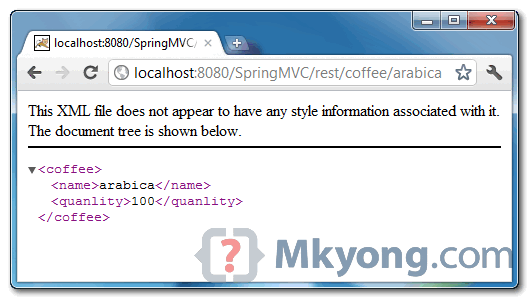Spring 3 MVC And XML Example
2012-11-23 00:38
489 查看
In Spring 3, one of the feature of “mvc:annotation-driven“, is support for convert object to/from XML file, if JAXB is in project classpath.
In this tutorial, we show you how to convert a return object into XML format and return it back to user via Spring @MVC framework.
Technologies used :
Spring 3.0.5.RELEASE
JDK 1.6
Eclipse 3.6
Maven 3
JAXB in JDK6
JAXB is included in JDK6, so, you do not need to include JAXB library manually, as long as object is annotated with JAXB annotation, Spring will convert it into XML format automatically.
package com.mkyong.common.model;
import javax.xml.bind.annotation.XmlElement;
import javax.xml.bind.annotation.XmlRootElement;
@XmlRootElement(name = "coffee")
public class Coffee {
String name;
int quanlity;
public String getName() {
return name;
}
@XmlElement
public void setName(String name) {
this.name = name;
}
public int getQuanlity() {
return quanlity;
}
@XmlElement
public void setQuanlity(int quanlity) {
this.quanlity = quanlity;
}
public Coffee(String name, int quanlity) {
this.name = name;
this.quanlity = quanlity;
}
public Coffee() {
}
}
As i know, when Spring see
Object annotated with JAXB
JAXB library existed in classpath
“mvc:annotation-driven” is enabled
Return method annotated with @ResponseBody
It will handle the conversion automatically.
package com.mkyong.common.controller;
import org.springframework.stereotype.Controller;
import org.springframework.web.bind.annotation.PathVariable;
import org.springframework.web.bind.annotation.RequestMapping;
import org.springframework.web.bind.annotation.RequestMethod;
import org.springframework.web.bind.annotation.ResponseBody;
import com.mkyong.common.model.Coffee;
@Controller
@RequestMapping("/coffee")
public class XMLController {
@RequestMapping(value="{name}", method = RequestMethod.GET)
public @ResponseBody Coffee getCoffeeInXML(@PathVariable String name) {
Coffee coffee = new Coffee(name, 100);
return coffee;
}
}
<beans xmlns="http://www.springframework.org/schema/beans"
xmlns:context="http://www.springframework.org/schema/context"
xmlns:mvc="http://www.springframework.org/schema/mvc"
xmlns:xsi="http://www.w3.org/2001/XMLSchema-instance"
xsi:schemaLocation="
http://www.springframework.org/schema/beans http://www.springframework.org/schema/beans/spring-beans-3.0.xsd http://www.springframework.org/schema/context http://www.springframework.org/schema/context/spring-context-3.0.xsd http://www.springframework.org/schema/mvc http://www.springframework.org/schema/mvc/spring-mvc-3.0.xsd">
<context:component-scan base-package="com.mkyong.common.controller" />
<mvc:annotation-driven />
</beans>
Note
Alternatively, you can declares “spring-oxm.jar” dependency and include following
<beans ...>
<bean class="org.springframework.web.servlet.view.BeanNameViewResolver" />
<bean id="xmlViewer"
class="org.springframework.web.servlet.view.xml.MarshallingView">
<constructor-arg>
<bean class="org.springframework.oxm.jaxb.Jaxb2Marshaller">
<property name="classesToBeBound">
<list>
<value>com.mkyong.common.model.Coffee</value>
</list>
</property>
</bean>
</constructor-arg>
</bean>
</beans>

In this tutorial, we show you how to convert a return object into XML format and return it back to user via Spring @MVC framework.
Technologies used :
Spring 3.0.5.RELEASE
JDK 1.6
Eclipse 3.6
Maven 3
JAXB in JDK6
JAXB is included in JDK6, so, you do not need to include JAXB library manually, as long as object is annotated with JAXB annotation, Spring will convert it into XML format automatically.
2. Model + JAXB
A simple POJO model and annotated with JAXB annotation, later convert this object into XML output.package com.mkyong.common.model;
import javax.xml.bind.annotation.XmlElement;
import javax.xml.bind.annotation.XmlRootElement;
@XmlRootElement(name = "coffee")
public class Coffee {
String name;
int quanlity;
public String getName() {
return name;
}
@XmlElement
public void setName(String name) {
this.name = name;
}
public int getQuanlity() {
return quanlity;
}
@XmlElement
public void setQuanlity(int quanlity) {
this.quanlity = quanlity;
}
public Coffee(String name, int quanlity) {
this.name = name;
this.quanlity = quanlity;
}
public Coffee() {
}
}
3. Controller
Add “@ResponseBody” in the method return value, no much detail in the Spring documentation.As i know, when Spring see
Object annotated with JAXB
JAXB library existed in classpath
“mvc:annotation-driven” is enabled
Return method annotated with @ResponseBody
It will handle the conversion automatically.
package com.mkyong.common.controller;
import org.springframework.stereotype.Controller;
import org.springframework.web.bind.annotation.PathVariable;
import org.springframework.web.bind.annotation.RequestMapping;
import org.springframework.web.bind.annotation.RequestMethod;
import org.springframework.web.bind.annotation.ResponseBody;
import com.mkyong.common.model.Coffee;
@Controller
@RequestMapping("/coffee")
public class XMLController {
@RequestMapping(value="{name}", method = RequestMethod.GET)
public @ResponseBody Coffee getCoffeeInXML(@PathVariable String name) {
Coffee coffee = new Coffee(name, 100);
return coffee;
}
}
4. mvc:annotation-driven
In one of your Spring configuration XML file, enable “mvc:annotation-driven“.
<beans xmlns="http://www.springframework.org/schema/beans"
xmlns:context="http://www.springframework.org/schema/context"
xmlns:mvc="http://www.springframework.org/schema/mvc"
xmlns:xsi="http://www.w3.org/2001/XMLSchema-instance"
xsi:schemaLocation="
http://www.springframework.org/schema/beans http://www.springframework.org/schema/beans/spring-beans-3.0.xsd http://www.springframework.org/schema/context http://www.springframework.org/schema/context/spring-context-3.0.xsd http://www.springframework.org/schema/mvc http://www.springframework.org/schema/mvc/spring-mvc-3.0.xsd">
<context:component-scan base-package="com.mkyong.common.controller" />
<mvc:annotation-driven />
</beans>
Note
Alternatively, you can declares “spring-oxm.jar” dependency and include following
MarshallingView, to handle the conversion. With this method, you don’t need annotate @ResponseBody in your method.
<beans ...>
<bean class="org.springframework.web.servlet.view.BeanNameViewResolver" />
<bean id="xmlViewer"
class="org.springframework.web.servlet.view.xml.MarshallingView">
<constructor-arg>
<bean class="org.springframework.oxm.jaxb.Jaxb2Marshaller">
<property name="classesToBeBound">
<list>
<value>com.mkyong.common.model.Coffee</value>
</list>
</property>
</bean>
</constructor-arg>
</bean>
</beans>
5. Demo
URL : http://localhost:8080/SpringMVC/rest/coffee/arabica
Download Source Code
Download it – SpringMVC-XML-Example.zip (7 KB)相关文章推荐
- Spring 3 MVC and XML example
- Spring 3 MVC And XML Example springmvc3 返回XMl
- Spring 3 MVC and XML example
- Spring 3 MVC And RSS Feed Example
- 实现Spring 4 MVC HelloWorld Tutorial – Full XML Example
- Spring 3 MVC and JSON example
- Spring 3 MVC and RSS feed example
- Spring 4 MVC HelloWorld Tutorial – Full XML Example
- Spring 3 MVC Framework Based Hello World Web Application Example Using Maven, Eclipse IDE And Tomcat
- Spring MVC Display, Validate and Submit Form Example
- Spring MVC File Upload Example Tutorial – Single and Multiple Files
- Spring MVC Form Validation Example using Annotation and Custom Validator implementation
- Spring 3 MVC and JSON example
- Spring MVC + Mybatis+MySQL File Upload and Download Example
- Spring 3 MVC And JSON Example
- Spring MVC XmlViewResolver example
- Spring MVC Checkbox And Checkboxes Example
- Spring MVC radiobutton and radiobuttons example
- Spring MVC radiobutton and radiobuttons example
- Spring MVC with ParameterizableViewController Tutorial and Example
